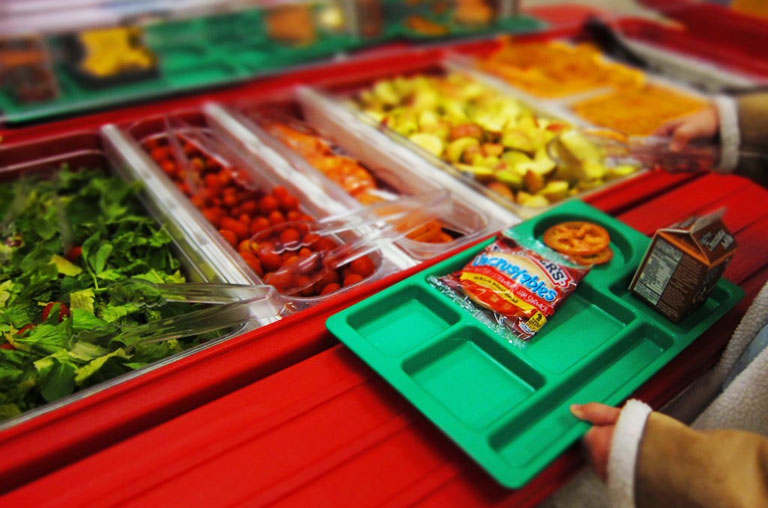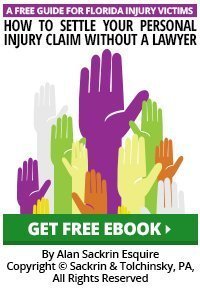Updated: 2/9/23
How Do You Know If A Business Acted Reasonably?
Unfortunately, South Floridians and our visitors are no strangers to slip and falls in cafeterias. We have all kinds of cafeterias, including those at local public schools and university dining halls, as well as restaurant cafeterias, like the popular Piccadilly Cafeteria chain here in the Miami area.
If a slip and fall occurs at one of these venues, then the victim will be required to prove that the owner or operator of the cafeteria was negligent by showing how they failed to act reasonably in preventing an accident and protecting their customers.
Slip and Fall Law In Florida
Someone who is injured by a slip and fall in a cafeteria due to the negligence of the owner or operator can suffer serious loss as a result. Under Florida law, the losses which can be recovered from the negligent party include:
- lost wages,
- hospital bills,
- pain and suffering,
- emergency room expenses,
- physical therapy,
- ambulance expenses, and
- other economic and non-economic damages.
Read: Economic vs Non-Economic Damages
Our state’s “premises liability” law says a cafeteria owner or operator is responsible to pay for the slip and fall victim’s damages, or losses if the accident victim can prove that (1) the cafeteria had notice of a condition that would cause a slip and fall and the condition causing the fall was the actual and proximate cause of that accident and (2) the victim was harmed as a result of the cafeteria’s negligence.
In other words, if the cafeteria owner/staff failed to act reasonably to protect its patron from falling and being hurt on its business property, then it is legally liable for that person’s damages.
How Do You Know If A Cafeteria Owner or Operator Acted Reasonably In Preventing a Slip and Fall?
Besides government regulations, a useful resource to examine when evaluating whether or not a cafeteria owner or operator acted reasonably is the risk control recommendations made by their insurance company.
There are several national insurance companies that provide coverage for slip and fall accidents in cafeterias. These insurance carriers are in the business of providing accident policies tailored to the food services industry like cafeterias, as well as fast food franchises, gourmet restaurants, etc. They are well versed in how those in the restaurant business (particularly cafeterias) should operate safely.
Cafeteria Insurance Company Risk Manuals
Since the insurance company will be the party paying the damage claim, they work hard to understand how slip and fall accidents can happen in a cafeteria, and what steps can be taken to minimize the risks of slip and fall accidents.
These insurance companies compile their research studies and past experience in risk manuals. Many of these cafeteria insurance carrier risk manuals are available online, including those provided by Travelers, CNA, and Zurich.
Government Oversight of Cafeteria Safety
There are also Federal laws and regulations that govern how cafeteria operations are to be performed for maximum safety. Federal agencies like OSHA (Occupational Safety and Health Administration) and state agencies, such as the one published online by the University of California system, publish studies on the risk of slip and fall accidents in cafeteria settings.
These studies focus on increasing the safety for both patrons of cafeterias as well as cafeteria workers, as a public service. Laws support them in various ways. For instance, OSHA can inspect both public and private cafeterias and issue fines to cafeteria operators failing to meet OSHA safety regulations. The Americans With Disabilities Act (ADA) also sets federal standards for cafeteria premises, and the failure to comply with ADA statutes can result in fines and more.
See the EEOC’s ADA Guide for Restaurants here.
Questions and Issues to Consider After a Florida Cafeteria Slip and Fall Accident
When evaluating whether or not to proceed with a slip and fall claim against the owner or operator of the cafeteria, you’ll want to evaluate the strength of your case.
How do you know how strong your claim is against the cafeteria?
The more evidence that you can gather regarding what happened to you, and what the cafeteria owner or operator did (or failed to do) to prevent a slip and fall accident on their property, the better your chances are of achieving a satisfactory resolution of your claim.
Evidence can include both witness testimony, as well as documentary evidence like photos, police reports, video surveillance, medical reports, etc.
Read: Documentary Evidence in Florida Personal Injury Cases
The keys here are to be organized and to be educated when negotiating with the insurance adjuster or the defense attorney.
Can you point to specifics that show the failure of the cafeteria to act in a reasonable and prudent manner to prevent your slip and fall accident?
Here are some questions we have compiled from our past experience with slip and falls and from several online risk manuals provided by food services insurance carriers that may help you evaluate your case against the Florida cafeteria. These questions include some taken from the above-referenced risk manuals published online by Traveler’s Insurance, CNA, and Zurich.
1. Condition of the Cafeteria Floor
- What was the condition of the floor itself at the time of the slip and fall? Was it slippery? Was it wet? Was it slick from grease or oil? Was it slippery from food particles?
- If something that fell on the floor caused your slip and fall accident, how long had it been there? What was it? Who put it there? When was it removed? Who removed it? Was it their customary job to do so?
- Were there floor mats in the area where you slipped and fell? If not, why not?
- If so, were these floor mats slip-resistant? Were they in good condition, or were they frayed or otherwise damaged or used?
- If you fell in the kitchen or food prep area, then what was the condition of the floor in the cooking area? The dishwashing area? The paths leading to and from the kitchen to the serving area?
2. Furniture
- Was there any cafeteria furniture near you at the time you fell? Did it hamper you?
- What was the condition of the furniture (the chairs, the table, the tray stand, etc.)? Was it in good condition?
- Was the cafeteria furniture designed for this purpose? Was it stable? Was it sturdy?
3. Trash
- Where were the trash receptacles located in the cafeteria? Were there enough trash cans? Were they clean?
- Was there any trash overflowing from them?
- Did they smell? Were they sticky? Failure to maintain trash receptacles in a food services setting is often a sign that other cafeteria maintenance is not being performed, as well.
4. Clean Up
- How often is the cafeteria swept?
- How often is the cafeteria mopped?
- How often are the cafeteria tables wiped?
- How often are the cafeteria trays picked up?
5. Caution Warnings
- When there is a spill or the floors are freshly mopped, are “Wet Floor” signs placed there as a warning?
- Are there caution signs like “wet floor” used in the cafeteria?
- Where are they kept? Who is responsible for putting them out as a public warning?
- Who is responsible for putting caution signs out in the private kitchen and prep areas?
6. Foreign Substances
- If you tripped over something on the floor, what was it? Was it a food item? Was it debris of some sort? Was it a chair, stool, tray, or another item?
- Who is responsible for removing hazards off the cafeteria floor? How often do they do this? Why wasn’t this done before you fell and were hurt?
7. Maintenance of the Cafeteria
- How fast are cafeteria employees instructed to clean up spills? How fast does this really happen?
- How often are cafeteria employees instructed to sweep the floors? How often does this really occur?
- How often are cafeteria employees instructed to wipe off counters? How often does this really occur?
- How often are cafeteria employees instructed to wipe off handrails or supports? How often does this really occur?
8. Dishes and Trays
- Does the cafeteria provide covers for drinks to minimize spills? If not, why not?
- Does the cafeteria provide napkins and trays to protect against spills? If not, why not?
9. Ramps and Rails
- Are there ramps and rails to help people carrying food items to move safety through the cafeteria, from the food line to the tables to the cash register?
- Are there ramps and rails to help people easily access and exit the cafeteria?
- Do these support systems comply with the ADA?
10. Workers’ Attire
- What requirements are made upon the cafeteria workers’ attire: do they have to wear hair nets?
- Do they have to wear shoes that are closed-toed? Are they required to wear shoes that are not high-heeled? Must their shoes have non-slip soles?
11. Third Parties
- Have there been any repairs made on the cafeteria in the past six months? If so, who did the repairs? Did they contribute to the fall accident?
- Is there a third-party cleaning service that cleans the cafeteria before, during, or after closing? If so, have there been complaints about this cleaning service? Have any other slip and fall accidents happened in locations they service in the past year?
Do You Have a Slip and Fall Damages Claim Against a Florida Cafeteria?
If you or a loved one have been the victim of a slip and fall accident that happened in a cafeteria here in South Florida, then you may want to investigate possible legal claims against the owner and operator of that cafeteria with an experienced Florida personal injury lawyer.
If the business that owns or operates that cafeteria failed to act reasonably to prevent that slip and fall or trip and fall accident, it may be legally obligated to cover the injury damages resulting from that fall, including physical therapy expenses, pain and suffering, medical costs, lost wages, and more.
A good piece of advice if you or a loved one has been injured in a cafeteria slip and fall, is to speak with an experienced personal injury lawyer to learn about some of the issues that can arise with these claims, including the type of evidence needed to prove a claim and the type and amount of damages you can recover. Most personal injury lawyers, like Alan Sackrin, will offer a free initial consultation (over the phone or in person, whichever you prefer) to answer your questions.
_______________
 Do you have questions or comments? Then please feel free to send Alan an email or call him now at (954) 458-8655.
Do you have questions or comments? Then please feel free to send Alan an email or call him now at (954) 458-8655.
If you found this information helpful, please share this article and bookmark it for your future reference.

